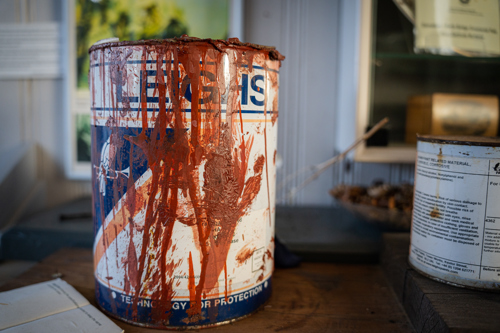West footpath/cycleway is currently closed for essential maintenance, please use the east footpath/cycleway.
Access Restrictions
Painting The Forth Bridge
A Never Ending Task?
Everyone knows that painting the Forth Bridge is a huge task. So huge, that once you finish one end, you have to start again at the other, right? It’s such common knowledge that the phrase ‘like painting the Forth Bridge’ has entered everyday parlance to mean a never-ending task.
Whilst it’s true that the structure used to require continuous painting, technology has moved on and the Forth Bridge now only needs painting roughly every twenty-five years.
When the bridge was built, it was painted in the distinctive red oxide colour that is now known as Forth Bridge red.
Maintenance was a constant battle against the ravages of the wind, rain and fog. Workers balanced on rope cradles with a paint pot in one hand and a large round brush in the other. It was precarious work, especially for those painting the top of the towers. A head for heights was essential!
The paint itself was mixed by a hand-operated paint mixer, made by Torrence & Sons Ltd of Bitton, Bristol, in around 1923. The mixer is now an exhibit in 101 of Edinburgh’s Most Treasured Objects and can be seen in the National Museum of Scotland. When the bridge was renovated, workers found old pennies painted into the bridge – perhaps the painters' way of leaving their own legacy.
By the 1990s, the bridge was deteriorating. Flaking paint was detaching from the steel and allowing patches of corrosion. It was time for a full restoration job.
However, restoring this Victorian icon without disrupting the east coast mainline rail link was no easy feat. Bespoke scaffolding systems – with new support points built and welded to the bridge – were required.
Every inch of the bridge was then inspected and every hour saw the removal of nearly 20 tonnes of debris by industrial vacuum extractor units.

The master stroke was a new painting system, applied under climate-controlled, optimum conditions. Whilst still labour intensive – all 6.5 million rivets and leading edges of surfaces had to be hand-painted – the new formula is much more durable. The high-build epoxy glass-flake paint is expected to last up to twenty-five years.
This marks an end to the never-ending task but the myth still prevails. Google searches for ‘painting the Forth Bridge’ remain high and in a recent episode of the TV programme QI, the klaxon sounded when Rob Brydon stated that the bridge needed continuous painting.
The Forth Bridge – and the painting of it - is well established in popular culture and we think that’s a great sign of our affection for the bridge. For as long as the myth continues, we’ll enjoy it - and won’t insist that the facts get in the way of a good story!



